Related Research Articles
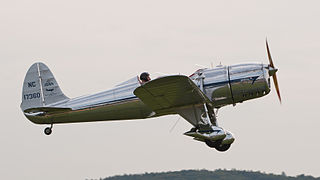
The Ryan STs were a series of two seat, low-wing monoplane aircraft built in the United States by the Ryan Aeronautical Company. They were used as sport aircraft, as well as trainers by flying schools and the militaries of several countries.

The Bellanca 28-92 Trimotor was a racing aircraft built to compete in the Istres-Damascus-Paris Air Race of 1937, and was paid for by popular subscription in Romania. Christened Alba Julia it was piloted by Captain Alexander Papana of the Romanian Air Force.
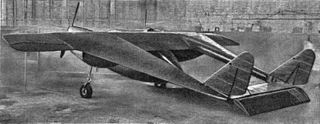
The Willoughby Delta 8, or Delta F was a small twin-engined aerodynamic test bed for a proposed flying wing airliner - the Delta 9. The Delta 8 flew in the United Kingdom for a few months during 1939 before crashing; there were no developments.
The Nakajima P-1 was a 1930s Japanese single engine, single seat biplane intended for night mail flights, derived from the Nakajima E4N3 Naval reconnaissance seaplane. Nine were built.
The Lemberger LD20b was a single-engine cantilever biplane designed to be easily towable behind a car. Built in Germany in 1971, it made several flights but did not enter production.

The Waterman Arrowbile was a tailless, two-seat, single-engine, pusher configuration roadable aircraft built in the US in the late 1930s. One of the first of its kind, it flew safely but generated little customer interest, and only five were produced.
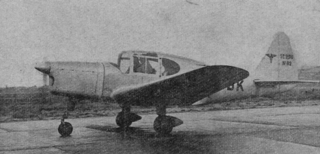
The Sud-Est SE-2300 or S.N.C.A.S.E. SE-2300 was a two/three seat low wing, single engine touring aircraft, built just after World War II in France. The SE-2310 was a tricycle undercarriage variant. Neither type went into production.
The Stephens Akro is a single engine monoplane designed in the United States for aerobatic competitions. It first flew in 1967 and proved very successful, leading to several developments of which one won seven US Championships and one World Championship between 1975 and 1982. The Extra EA-230 and Extra EA-300 were also Akro developments with over two hundred built.

The Gribovsky G-22 was a low powered, single seat sports cantilever monoplane, designed and built in the USSR in the mid-1930s. It set at least one class record and flew from 1936 to at least 1940, though only one was completed.

The Caudron Type O was a French single seat air racing biplane first flown in 1914.
The Marc Parrot, named after the Punta Parrot peak in the Monte Rosa Massif, was specifically designed to fly into unprepared fields and mountain landing strips. The prototype first flew in 2013 but no more had been completed by about 2015.
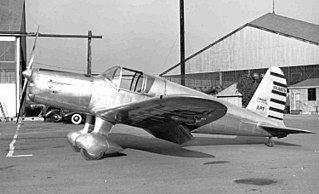
The Aeroneer 1-B is an all-metal light aircraft built in the United States in 1936. It did not reach production, despite an attempt to interest the USAAC in it as a trainer, but it appeared in three Hollywood films.
The Hockaday Comet was a two-seat light civil aircraft, built in the United States before World War II but not flown until near the war's end. It failed to attract buyers and only one was completed.
The Möller Stomo 3 was a small, low-powered but very aerodynamically-clean light aircraft, first flown in Germany in 1939. It set two speed over distance records for aircraft with engines of less than 2 l (120 cu in) capacity soon after its first flight.

The Miami Maid was a US three passenger amphibian first flown in 1929. Despite ambitious production plans, only two were built.

The Lincoln AP was a U.S., single engine, high wing, general purpose civil cabin aircraft first flown in 1930. Only four were built.

The Ogden Osprey was a three engine, high wing monoplane airliner which seated six. Designed in the United States and first flown in the spring of 1930 or earlier, six were built and some used commercially before Ogden Aeronautical ceased trading in the Great Depression.
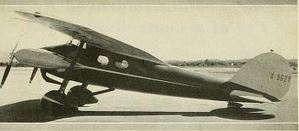
The Alcor Duo-4 was a high wing cabin aircraft, unusually powered by a pair of four cylinder straight engines mounted horizontally either side of the nose. After an accident it was rebuilt with six cylinder engines, becoming the Alcor Duo-6. The name Alcor derived from Allan Lockheed Corporation.
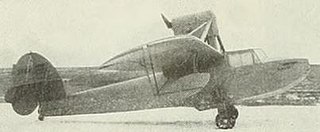
The Argonaut Pirate was a 1930s, U.S., three place, single-engined pusher configuration amphibious aircraft. Only two were built.
The Waterman Flex-Wing was a four seat cabin aircraft designed to be easy for non-expert pilots to fly. Its principle safety features were based on a hinged wing providing controllable and interconnected dihedral and incidence. Two were built but the absence of funding in the difficult trading conditions of the Great Depression ended the project.
References
- 1 2 3 4 5 "Ben Jones Sports Plane". Aero Digest. 29 (6): 42. December 1936.
- ↑ "Aerofiles:Jones" . Retrieved 13 May 2021.